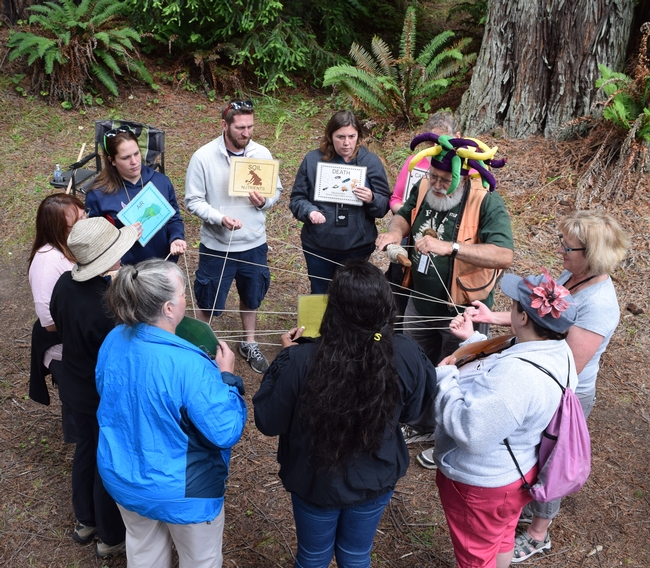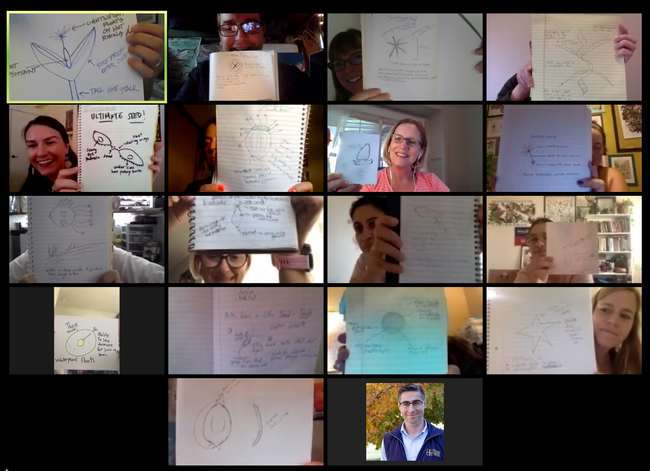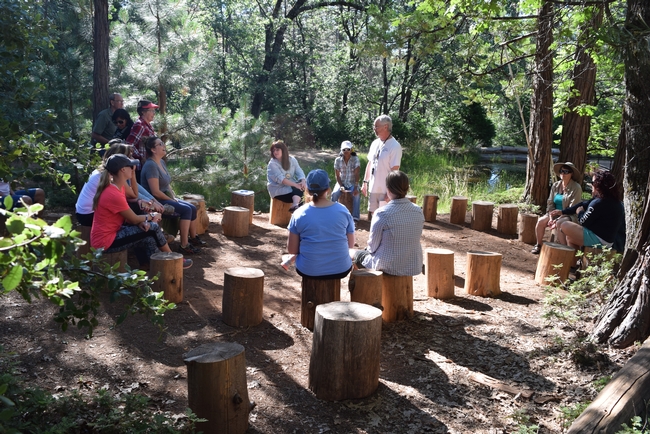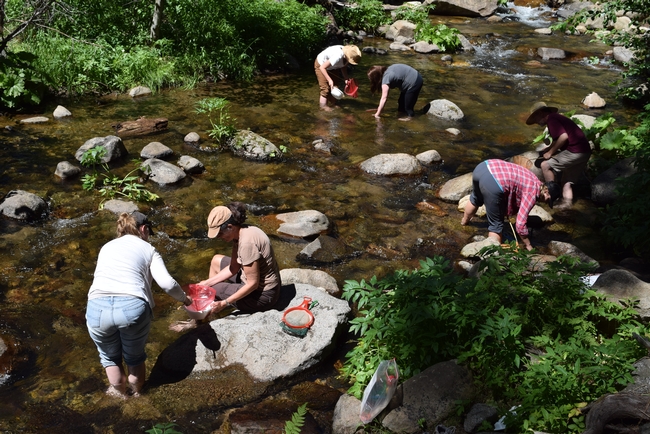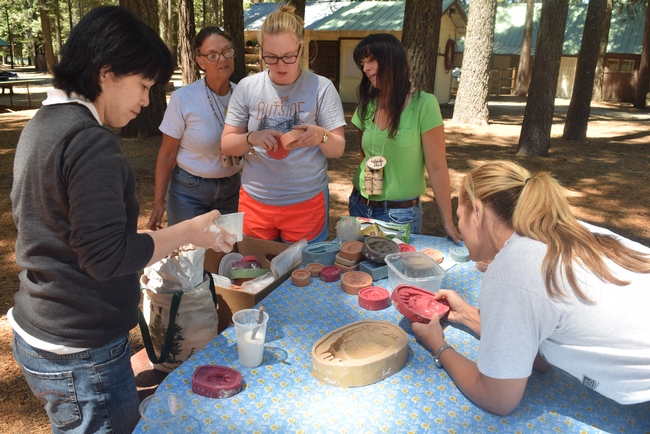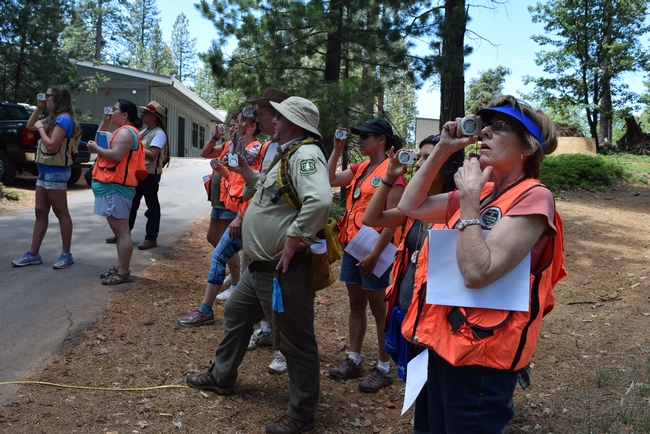
Posts Tagged: Project Learning Tree
UC Inspires a Love of Nature to Ensure Future Environmentalists
Children learn math, reading and writing in school to prepare them for their future...
UC inspires a love of nature to ensure future environmentalists
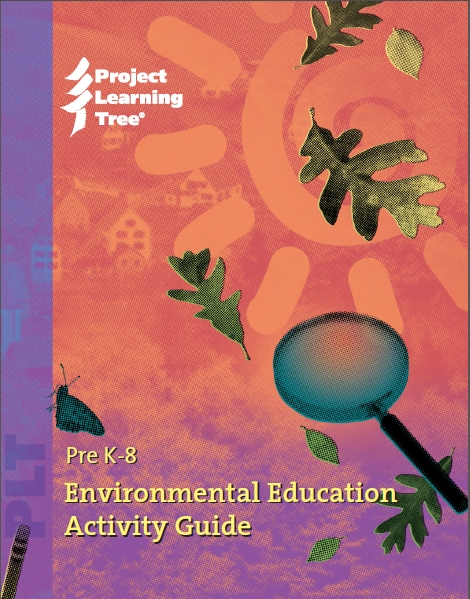
UC ANR provides the California home of Project Learning Tree, a national program founded in 1973, during the height of an environmental movement sparked by Rachel Carson's seminal book Silent Spring.
“Everyone began to realize we were having an impact on the environment,” said Sandra Derby, Project Learning Tree state coordinator.
Project Learning Tree (PLT), working with the forestry industry, developed an environmental education program and trained teachers to present it to children in formal and informal educational settings. In California, the program is funded by CAL FIRE.
Another UC ANR program, UC California Naturalist, has collaborated with PLT since 2013.
“There is a lot of shared interest in environmental education, stewardship and service in our two programs,” said Greg Ira, director of UC California Naturalist (CalNat). The CalNat Program recruits and certifies a diverse community of volunteers across California to conduct nature education and interpretation, stewardship, participatory science and environmental program support.
During the coronavirus pandemic, CalNat offered PLT courses to school teachers, volunteer educators and parents online. Completion of the six-hour course over three days resulted in their certification for teaching PLT curricula. The book, aimed for children pre-kindergarten to eighth grade, includes 96 activities, with objectives, assessment opportunities, online teaching connections, and more.
The teacher training course offered by CalNat engages participants with the same activities they will employ when teaching nature appreciation to children.
Learning to appreciate the environment
Even though online training focuses attention on a computer screen, the PLT curriculum gets pupils outside. After writing about and discussing a favorite tree from memory, the participants were asked to go outside to gather a variety of leaves around their homes, classrooms or offices. They observed leaf details, and sorted them by observable characteristics.
The participants reconvened and shared their leaves, divided into categories onscreen: Leaves with rough edges, rounded, oval or palmate; rough, waxy, furry and thick; drooping down or reaching up.
Teachers can use additional activities outlined in the curriculum to help students understand natural variations and biodiversity by engaging with the leaves through observation and art. For example, if the training is taking place in person, the children can trade leaves and then look for the trees where their peers found them. Or they can put a leaf under a plain piece of paper and rub the side of a crayon across it to show the leaf's margin, veins and other details.
There are also activities related to common core skills and abilities. For example, different leaf characteristics can be charted in a Venn diagram, with leaves' common characteristics appearing in the center – such as green, pliable, veins – and singular characteristics in the sections that do not overlap.
Making environmental learning accessible
PLT advances environmental literacy using trees and forests as windows on the world, said Cynthia Chavez, PLT community education specialist in Southern California. The hands-on, engaging activities help “teach students how to think, not what to think” about the environment and their place within it.
“Environmental education could be taught in a daunting way,” Chavez said. “PLT opens the door to kids who are different kinds of learners. This is important for environmental education.”
PLT's comprehensive collection of activities have won the confidence of the education community. Curricula is only offered to teachers who have completed workshops so PLT can share a proven system of implementation.
“PLT training encourages students to care for the environment and be interested in pursuing careers in environmentalism. They learn science is not just in the classroom. They could become a field biologist, if that's the way their brain works,” Chavez said.
Expressing engagement with nature in words
Among the ways to connect with nature outlined in the PLT curriculum are reading, journaling and writing. To close the educator training, participants were given 10 minutes outside to draw inspiration from nature and write a poem – haiku, free verse, rhyming or other style.
Below are samples of poetic nature observations written on the fly by teachers who will inspire California young people to appreciate and help conserve the natural world with the help of PLT.
Haiku:
A droplet of sun
Planted firmly in soil
Linking earth to sky
Free verse:
I have botany blindness, always looking for things that scurry, not sway
But I am asked to acknowledge the tree, and I do
A lone palo verde
There's a chevron lizard on the trunk
A small, yellow verdin in the branches
A line of busy ants along the roots
So I am grateful for this tree, after all
It sways, and upon closer inspection, it scurries as well
Rhyming:
A fly comes by
As wind hits my hair
Almost as if
It moved here and there
Then Winston, my dog
Hears someone bark
And a bird starts to chirp
Like a crow or a lark
|
Green Jobs Personality Quiz Project Learning Tree offers a one-time free trial intended for adults to test its Green Jobs Quiz. The quiz helps kids learn what green job fits their personalities. You'll receive information about how to administer this quiz to youth you work with. |
Forest Ecology + Field Skills + Camp = An Amazing Experience!
As a 4-H leader participating in the 2018 California 4-H Camping Conference, you can sign up for...
A great line-up at the 2018 California 4-H Camping Conference
Every two years, volunteers, youth and staff gather to learn, explore, and connect at the...
Free forestry workshops to help teachers meet new science standards
California's K-12 teachers are being challenged by the Next Generation Science Standards to find new and more engaging ways to teach science. Adopted by California in 2013, the science-education standards guide how science, technology, engineering and math education are delivered to students in the classroom. The Forestry Institute for Teachers (FIT) offers free environmental education training for teachers in a northern California forest.
“Teachers who participate in the Forestry Institute for Teachers learn to apply Next Generation Science Standards concepts as they develop or refine class lessons using the forest as a lens through which all classroom subject matter can be taught,” said Mike De Lasaux, UC Cooperative Extension natural resources advisor for Plumas and Sierra counties and a FIT instructor.
Learning science through FIT's participatory model is more exciting than memorizing facts from a textbook. In the forest, FIT instructors point out opportunities for students to use technology, engineering and math to better understand the world around them. For example, math can be used to estimate the height of a towering tree. Seeing the “web of life” relationships, such as the effects of rainfall and insects on tree growth, leads to more critical thinking to solve problems.
“The goal of the Forestry Institute for Teachers is to provide K-12 teachers with knowledge, skills and tools to effectively teach their students about forest ecology and forest resource management practices and much more,” said De Lasaux.
California teachers from rural and urban settings are invited to spend a week during the summer working outdoors with natural resources experts to gain a deeper understanding of forest ecosystems and human use of natural resources. The participants are organized by grade level for age-appropriate activities. They take field-trips and do hands-on activities such as examining the rings in a tree's cross-section to learn about events – such as wet or dry periods, insect or disease damage – that have occurred during the tree's lifetime.
The Forestry Institute for Teachers has been providing science education and other subject content to California K-12 teachers since 1993 with more than 2,500 educators completing the program.
FIT is a week-long residence program developed by the Northern California Society of American Foresters in collaboration with the University of California Agriculture and Natural Resources' Cooperative Extension, the USDA Forest Service, CALFIRE and other entities. The FIT Program is underwritten by a consortium of public and private sources.
FIT is offered in forested settings in four different Northern California locations:
- June 11-17 in Plumas County
- June 18-24 in Tuolumne County
- July 2-8 in Shasta County
- July 9-15 in Humboldt County
There is an application fee of $25, but training, meals and lodging are free for first-time participants.To watch videos of past participants discussing their FIT experience and to apply to attend, visit www.forestryinstitute.org.